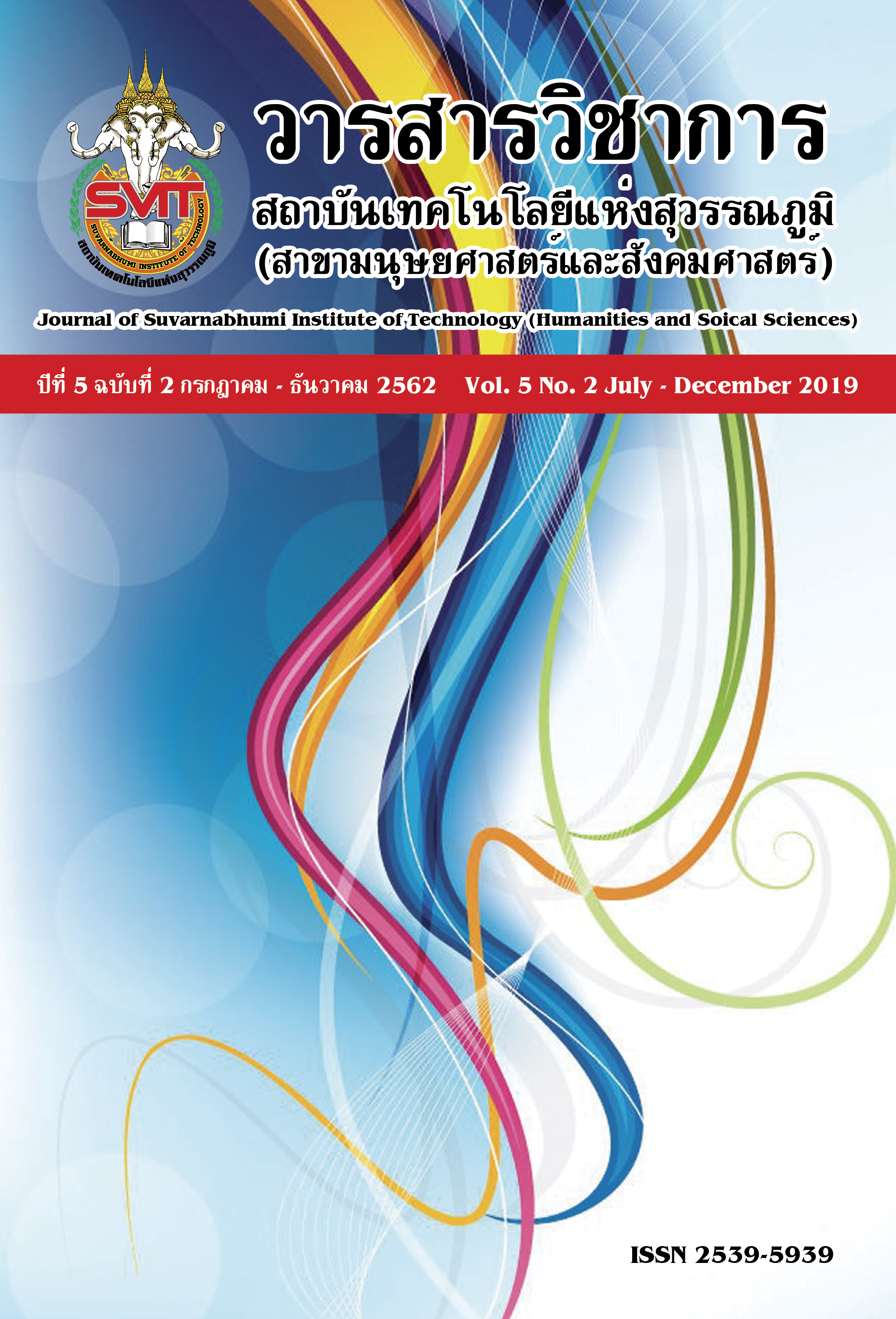THE EFFECT OF GENDER AND PERSONALITY DIFFERENCES IN YOUNG ADULTS ON THE EMOTIONAL DOMINANCE OF THAI TEXTS AND PICTURES
Keywords:
Thai Texts and Pictures, Emotional Dominance, Young adultsAbstract
Emotions are feelings that result from receiving stimuli. There are complex mechanisms in the body. The emotions are both positive and negative. Push the behavior. Therefore the purpose of this experimental research was to design experimental activities of looking at Thai texts and Dominance pictures which stimulated Dominance emotions in young adults. The participants were eighty students who were 40 males and 40 females from Burapha University in the academic year 2017, aged between 19-24 years. There are extravert and ambivert personality groups. Right hand , Never had a brain injury , No depression, Positive and Negative emotions (PANAS) are normal, normal vision. All volunteers participate in research. The data were analyzed by using basic statistics, percentage, mean and standard deviation. Dominance emotional perception behavior between males and females who were extravert and ambivert personality was analyzed by two-way ANOVA.
The results showed that dominance emotion of the young adults on open personality and middle personality was significantly different at the level of .05 while looking at the Thai texts and Dominance pictures. No differences were found between sex and personality. There is no interaction between sex and personality on emotions in both fear and no fear.
References
ธวัชชัย ศรีพรงาม, เสรี ชัดแช้ม, และ สมพร สุทัศนีย์. (2558). การพัฒนาระบบคลังรูปภาพที่สื่อความหมายทางด้านอารมณ์ความรู้สึกในบริบทของคนไทย. วิทยาการวิจัยและวิทยาการปัญญา. 13(2), 57-70.
Ahveninen, J., Chang, W. T., Huang, S., Keil, B., Kopco, N., Rossi, S., Bonmassar, G., Witzel, T., & Polimeni, J. R. (2016). Intracortical depth analyses of frequency- sensitive regions of human auditory cortex using 7TfMR. NeuroImage, 143(2016), 116-127.
Campisi, p., & La Rocca, D. (2014). Brain waves for automatic biometric-based user recognition [Abstract]. IEEE Transactions on Information Forensics and Security, 9(5), 782–800.
Dan-Glauser, E. S., & Scherer, K. R. (2011). The Geneva affective picture database (GAPED): a new 730-picture database focusing on valence and normative significance. Behavior Research Methods, 43(2), 468-477.
Domes, G., Schulze, L., Bottger, M., Grossman, A., Huaenstein, K., Wirtz, P. H., Heinrichs, M. & Herpertz, S. C., (2010). The neural correlates of sex differences in emotional reactivity and emotion regulation [Abstract]. Human Brain Mapping, 31(5), 758-769.
Edmond, W. A. & Kennedy, T. D. (2017). An Applied Reference Guide to Research Designs: Quantitative, Qualitative, and Mixed Methods (2nd ed.). California: Sage Publication.
Kravitz, D. J., Saleem, K. S., Baker, C. I., Ungerleider, L. G., & Mishkin, M. (2013). The ventral visual pathway: an expanded neural framework for the processing of object quality. Trends in Cognitive Sciences, 17(1), 26-49.
Kret, M. E., & De Gelder, B. (2012). A review on sex differences in processing emotional signals. Neuropsychologia, 50(7), 1211-1221.
Bradley, M. M., & Lang, P. J. (2007). The International Affective Picture System (IAPS) in the Study of Emotion and Attention. In J. A. Coan, & J. J. B. Allen (Eds.), Handbook of Emotion Elicitation and Assessment (pp. 29-46).
London: Oxford University Press.
Mendoza-Halliday, D., Torres, S., & Martinez-Trujillo, J. C. (2014). Sharp emergence of feature-selective sustained activity along the dorsal visual pathway. Nature Neuroscience, 17(9), 1255-1262.
Mathes, M. T., Hinch, S. G., Cooke, S. J., Crossin, G. T., Patterson, D. A., Lotto, A. G., & Farrell, A. P. (2009). Effect of water temperature, timing, physiological condition, and lake thermal refugia on migrating adult Weaver Creek
sockeye salmon (Oncorhynchusnerka). Canadian Journal of Fisheries and Aquatic Sciences, 67(1), 70-84.
Palazova, M., Mantwill, K., Sommer, W., & Schacht, A. (2011). Are effects of emotion in single words non-lexical? Evidence from event-related brain potentials. Neuropsychologia, 49(9), 2766-2775.
Russell, J. A., & Mehrabian, A. (1977). Evidence for a three-factor theory of emotions [Abstract]. Journal of Research in Personality, 11(3), 273-294.
Tok, S., Koyuncu, M., Dural, S., & Catikkas, F. (2010). Evaluation of International Affective Picture System (IAPS) Ratings In An Athlete Population And Its Relations To Personality. Personality And Individual Differences, 49(5), 461-466
Yildiz, A., Akin, M., Poyraz, M., & Kirbas, G. (2009). Application of adaptive neuro-fuzzy inference system for vigilance level estimation by using wavelet-entropy feature extraction. Expert Systems with Applications, 36(4), 7390-7399.
Downloads
Published
Issue
Section
License
บทความที่ได้รับการตีพิมพ์เป็นลิขสิทธิ์ของวารสารวิชาการ สถาบันเทคโนโลยีแห่งสุวรรณภูมิ
ข้อความที่ปรากฏในบทความแต่ละเรื่องในวารสารวิชาการเล่มนี้เป็นความคิดเห็นส่วนตัวของผู้เขียนแต่ละท่านไม่เกี่ยวข้องกับสถาบันเทคโนโลยีแห่งสุวรรณภูมิ และคณาจารย์ท่านอื่นๆในสถาบันฯ แต่อย่างใด ความรับผิดชอบองค์ประกอบทั้งหมดของบทความแต่ละเรื่องเป็นของผู้เขียนแต่ละท่าน หากมีความผิดพลาดใดๆ ผู้เขียนแต่ละท่านจะรับผิดชอบบทความของตนเองแต่ผู้เดียว





